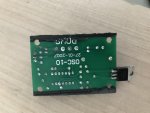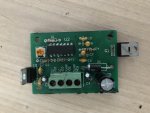Ebrownie
Member
So my snowmobile is a polaris 600 with an aftermarket turbo. Because the engine is a two stroke, you have to have a separate oiling system for the turbo since there is no engine oil in the crankcase. The turbo is a Garrett GT2860RS I believe. It is a ball bearing turbo so it does not need highly pressurized oil like a journal bearing turbo needs.
So recently my oil pump for my turbo quit working. After taking stuff apart and some research, I found that my pump is a Gotec emx 08-t/n. It is a 12v liquid pump, draws 1.5 A max. The pump works with an electromagnet and pulsed electricity which moves a piston back and forth. So if you hard-wire it to 12v dc, it does nothing. Because of this, the pump has a controller, which is a little circuit board that puts out pulsed dc at 50 hertz. Correct me if I’m wrong, but I believe it is also square wave, which is a 50% duty cycle? So it puts out a low frequency wave to quickly pulse the pump.
So the pump still worked fine when I hooked it up to a battery, but the controller is no longer functioning. No voltage comes out of it at all. I looked it up and found that the controller is a Clark PD-106, and it is meant specifically for gotec solenoid pumps. The problem is I can’t find a place where I can buy a new one.
I have been looking for a controller that could replace it, but I have not found one yet that seems to be a good match. There are plenty of pulse width modulators, but all of them are for dc motor rpm control and their frequency is way too high. I have found ones that you can adjust the frequency low enough, but they can’t handle more than 50 mA. So basically I need a controller that can handle 2 amps and that has an output frequency in the 20-100 hertz range.
A few of you guys are way more electronically savvy than I am and I was hoping someone could help me out with a solution.
http://www.gotecpumps.com/multimedia/docs/2009/06/EMX_08_-_Technical_data.pdf
https://www.clarksol.com/wp-content/uploads/2016/08/PD-106.pdf
First link is the pump, second is the controller circuit board.
So recently my oil pump for my turbo quit working. After taking stuff apart and some research, I found that my pump is a Gotec emx 08-t/n. It is a 12v liquid pump, draws 1.5 A max. The pump works with an electromagnet and pulsed electricity which moves a piston back and forth. So if you hard-wire it to 12v dc, it does nothing. Because of this, the pump has a controller, which is a little circuit board that puts out pulsed dc at 50 hertz. Correct me if I’m wrong, but I believe it is also square wave, which is a 50% duty cycle? So it puts out a low frequency wave to quickly pulse the pump.
So the pump still worked fine when I hooked it up to a battery, but the controller is no longer functioning. No voltage comes out of it at all. I looked it up and found that the controller is a Clark PD-106, and it is meant specifically for gotec solenoid pumps. The problem is I can’t find a place where I can buy a new one.
I have been looking for a controller that could replace it, but I have not found one yet that seems to be a good match. There are plenty of pulse width modulators, but all of them are for dc motor rpm control and their frequency is way too high. I have found ones that you can adjust the frequency low enough, but they can’t handle more than 50 mA. So basically I need a controller that can handle 2 amps and that has an output frequency in the 20-100 hertz range.
A few of you guys are way more electronically savvy than I am and I was hoping someone could help me out with a solution.
http://www.gotecpumps.com/multimedia/docs/2009/06/EMX_08_-_Technical_data.pdf
https://www.clarksol.com/wp-content/uploads/2016/08/PD-106.pdf
First link is the pump, second is the controller circuit board.


